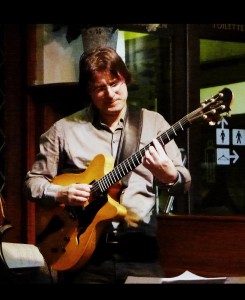Rhythm, melody and harmony…
As a guitar player I have always looked for ways to mix melody and harmony the same way piano players might do. Or fingerstyle guitarists for that matter.
An obvious example of mixing harmony and melody would be: playing a melody on top of a chord arrangement. Most guitar players use static chord grips under each melody note and simply move them around along with the melody. Instead of this, we could use separate melodic layers provided by a bass line, inner voices and off course the main melody (in top).
By giving a different rhythm to each melodic layer, we can create the illusion of multiple instruments. We watch a single player perform but we actually hear two, three or four players interact at the same time.
Mixing melody and harmony is a must also for solo improvisation. Melodies usually follow an underlying harmony (that’s why we have to learn to “play over the changes”). Not all chord tones are equally important when playing lines. The concept of voice-leading can help us to make a meaningful selection.
Piano players have ten fingers to bring out their melodies and chord melody arrangements. Guitarists only have four: (left) hand index, middle, ring fingers and pinky! Therefore minimising notes and making everything you play count, is crucial. Dividing big chords into smaller parts (single notes, double stops or triads) can really help here.
Rhythm is the ingredient that turns harmony and melody into music. We use rhythmic separation between layers in a chord melody arrangement. For melodic lines it comes down to questions like: how many notes do I have to go from one chord tone to the next? What different rhythms can I make with let’s say four notes? How can I subdivide a strain of eight notes? Listening to great recordings and transcribing solos by the great masters is indispensable when we want to learn about phrasing, swing, melodic flow etc.
For this purpose I have developed The Lyrebird Series ©, a collection of short articles and etudes (studies) that each can be mastered in one or two weeks. Articles give background information on general musical topics (‘What are Drop 2 shapes? What is voice-leading?”). Etudes (studies) focus on the jazz repertoire itself as the starting point for where ever the music wants to take us.
The course program will be decided by you and not limited by what a book or method has to offer! General topics include: learning a tune and being able to make a simple chord melody arrangement; developing clear melodic ideas; telling a story; playing together, becoming “readable” for other players. However, every lesson will put your personal needs in the center. Not one student will follow the exact same program!
All studies or articles are intended for the serious guitar student, amateur and professional alike. It is presumed that users have an elementary knowledge of tonalities and modes. Apart from that the information offered in every study should be pretty much self-explanatory. Feel free to contact me for more information.
